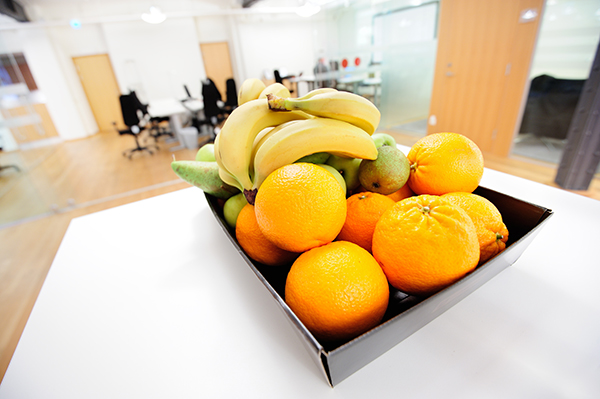Beat the 2 p.m. Slump at Work: 4 Strategies for a Healthy Afternoon
- By Elisabeth Flynn
- Reading Time: 4 mins.
It’s 2 p.m. You’ve had lunch, your inbox is full, and suddenly all you want is a nap. Sound familiar? That familiar crash in energy, known as the “afternoon slump,” hits many office workers like clockwork. It can tank productivity, increase mistakes, and lower morale. But while the slump feels inevitable, it doesn’t have to be.

Understanding what causes that mid-day dip—and how to counter it—can make a big difference in how you perform and feel throughout the day. We’ll dig into the science behind the afternoon slump and share some practical, workplace-friendly strategies to prevent it, including smart nutrition, energizing microbreaks, and more.
What Causes the Afternoon Slump?
Contrary to popular belief, the afternoon slump isn’t just the result of a heavy lunch. It’s tied to our body’s circadian rhythms—natural cycles that regulate energy, alertness, and sleepiness throughout the day. According to the National Sleep Foundation, our alertness tends to dip in the early afternoon, typically between 1 and 3 p.m.
But biology isn’t the only factor. Several lifestyle and workplace contributors can magnify this slump:
- Poor sleep hygiene: Inconsistent or insufficient sleep can deepen fatigue. Experts emphasize that even small disruptions in sleep can affect daytime energy regulation.
- High-sugar or carb-heavy lunches: Meals that cause blood sugar to spike and crash can lead to sluggishness and brain fog.
- Cognitive fatigue: Mental strain builds through the morning. A 2023 study by researchers from Texas A&M University found that office workers were less active and more error-prone in the afternoon, especially on Fridays.
How It Impacts the Workplace
For employers and office managers, the slump isn’t just a personal issue—it’s an organizational one. A fatigued workforce can lead to reduced productivity, slower decision-making, and disengagement. Left unaddressed, this pattern can sap team morale and long-term performance.
The Texas A&M study, which analyzed computer usage from nearly 800 in-office employees, revealed consistent productivity declines in the afternoon hours. Workers typed more slowly and made more mistakes. Once you understand these patterns, you can take action to break them.
The Best Strategies for a Healthy Afternoon
Thankfully, there are several simple, effective things you and your coworkers can do to stay energized and focused throughout the day. Here are four of the best strategies for a healthy afternoon:
1. Refresh Your Mind and Body with Microbreaks
Taking short breaks—as little as 5 to 10 minutes—can significantly reduce mental fatigue. These brief, intentional pauses in the workday give you a chance to “reset” through activities like light stretching, deep breathing, or a brief walk around the block. Microbreaks can improve mood, productivity, and creativity.

Encourage your team to:
- Step away from their desk once an hour
- Do shoulder rolls or standing stretches
- Breathe deeply or practice mindfulness for a few minutes
These simple steps can help employees return to their tasks with renewed energy and focus.
2. Fuel Focus with Healthy Snacks
Nutrition plays a crucial role in sustaining energy. Instead of high-sugar snacks that lead to crashes, provide options that stabilize blood sugar and boost brain power. Consider incorporating regular, healthy snack breaks into your office routine. You might be surprised to see an increase in focus and morale.

Great options include:
- Fresh fruit (bananas, apples, oranges, berries, etc.)
- Raw nuts and seeds (almonds, walnuts, sunflower seeds, etc.)
- Low-sugar yogurt or string cheese
- Whole-grain crackers with hummus
- Veggie sticks with nut butter
Want fresh fruit and snacks for work?
We've got you covered.Learn more about how fresh fruit supports your body by delivering natural energy, fiber, and essential nutrients that keep your brain and body performing well.
3. Encourage Movement Throughout the Day
Physical activity is a proven antidote to mental fatigue. Even a few minutes of movement can boost circulation, increase alertness, and reset attention.
You might try:
- Hosting five-minute walking meetings
- Organizing stretch breaks or desk yoga
- Using the stairs instead of the elevator
Studies from the Mayo Clinic and the National Institutes of Health (NIH) show that these movement breaks can significantly improve cognitive function, especially later in the day.
4. Practice Better Sleep Hygiene
Remember that last night’s rest plays a big role in your energy levels today. Adopt these habits to get the best quality sleep:
- Stick to consistent sleep and wake times
- Limit screen time before bed
- Avoid caffeine late in the day
Good sleep isn’t just recovery—it’s preparation for performance. NIH research underscores the critical link between sleep and brain function, showing how it affects everything from learning and forming memories to concentration and response time.
Create a Slump-Resistant Culture
Supporting your team through thoughtful wellness initiatives doesn’t have to be complicated. Consider leveling up your workplace with:
- Break rooms stocked with healthy, energizing snacks
- A company-wide culture of short, regular breaks
- Flexible meeting times that avoid the post-lunch dip
- Encouragement for physical movement during the day
These simple changes can help prevent burnout, improve morale, and keep your office energized from morning through afternoon.

Set Yourself Up for Success
The afternoon slump may be a natural part of our biology, but that doesn’t mean it has to derail your momentum. By using our best strategies for a healthy afternoon—including making healthy food choices, encouraging movement, and prioritizing rest—you and your team can stay energized, focused, and motivated all day long.
Looking for an easy way to energize your workplace? The FruitGuys offers fresh, nutritious snacks that support your team’s wellbeing—and delivers them right to your office.
Want fresh fruit and snacks for work?
We've got you covered.Recent Articles
Subscribe to our Newsletter
"*" indicates required fields





